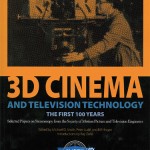One Hundred Years of 3D
Edited by Michael D. Smith, Peter Lude and Bill Hogan, Society of Motion Picture & Television Engineers, ISBN 978-1-61482-900-3.
Capturing images in three dimensions has been around for a long, long time, and with the current interest by both cinema and television players, it's interesting to examine some of the technology and techniques used or suggested by players in 3D's far-reaching history.
The Society of Motion Picture and Television Engineers has been around for a long time, too (the organization will observe its 100th birthday in 2016), and has served as perhaps the largest disseminator of information on 3D.
SMPTE's recent publication of a large compendium of 3D papers should come as no surprise then, especially since its founder, C. Francis Jenkins, was a very early proponent of stereoscopic motion-picture imaging. The new 550-page book appropriately leads off with a description of a patent issued to Jenkins on July 5, 1898, "Device for Obtaining Stereoscopic Effects in Exhibiting Pictures," and follows this with the oldest 3D motion-picture paper published in the SMPTE Journal (then SMPE), Jenkin's "Stereoscopic Motion Pictures," which first appeared in the October 1919 issue.
REFLECTIONS ON THE STATE OF THE ART
The new SMPTE book doesn't stop with 3D history long past either. The final chapter in this massive volume (it's about the same size and weight of a ream of copy paper) is titled "Stereoscopic Imaging Evolves 1961—Present" and concludes with a paper from Lenny Lipton of taking 3D imagery into the digital cinema environment.
For the techno-historians in the crowd, the book is a must-have, as it includes reflections on the state of the art from such giants as Bell Labs' Herbert Ives.
Be advised that this is not the sort of book that you sit down with and finish in one evening. This thick tome contains more than 50 complete papers published in the SMPE and SMPTE Journals, as well as a number of "letters to the editor," discussions, and even reproductions of newspaper and other articles ...
See the entire article here:
